What is fire suppression engineering? This is the development and preparation of documents, the totality of which will affect the correct equipping of the facility with the appropriate automatic fire extinguishing system.
This responsible production procedure is carried out by specialists from a company licensed by the Ministry of emergency situations. Our company “Integrated Security” is one of these companies.
It employs specialists with experience and qualifications. They the best way will be able to realize the ideas and desires of the customer. The designer’s intention regarding the protection of a specific object is reflected in project documentation, consisting of two parts - theoretical and graphic.
In the theoretical part, in addition to the calculations made, it is indicated what materials and equipment are involved in equipping the facility with an automatic fire extinguishing system. The basis for decision-making is the current rules and regulations.
Almost daily improvements in fire extinguishing technologies affect the improvement of equipment efficiency indicators. In a perfect and efficient fire fighting equipment, fire extinguishing agents are supplied using the latest methods submissions.
Robotic devices are being actively introduced around the world today. They eliminate the human factor, which can cause failure to complete planned tasks.
In Russia, new technical solutions have also been developed, where AUP RPK fire robots are involved in fire extinguishing technology. Patents confirm the novelty of such technical solutions. But despite all this, it is not yet possible to avoid specific calculations. For example, water foam or water fire extinguishing will function correctly with accurately performed hydraulic calculations.
And for long-term operation of powder and gas fire extinguishing installations, the correct calculation of the number of units and modules is necessary. There must be enough extinguishing agent to extinguish the fire. The safety of a particular object depends on professionally made calculations.
The graphic part of the project consists of documentation that indicates the placement of equipment on floor estimates. Also, in order to properly connect devices, lay cables and wires, information lines, a plan is needed for carrying out such work.
Work within the framework of orders and standardization based on quality project AUPT facilitates the installation of the necessary fire extinguishing system for a specific facility.
Fire suppression design begins with determining the type of building. They can be residential or non-residential, energized. These are also rooms with complex technical devices or stored valuables and so on.
The type of room also affects the choice of equipment for it. For example, in warehouses with a large amount of metal in them, it is best to extinguish the fire with powder fire extinguishing systems. When designing for libraries, consider gas installation, since water or foam can render important documents unusable.
Such a factor as temperature regime in the building also affects the type of extinguishing. Foam, water or mist sprinklers are used if the temperature will not drop below zero. If the temperature is lower, then it is advisable to use gas or powder fire extinguishing systems.
Design various systems taking into account what affects their efficiency, will bring savings and ensure excellent system performance. For example, when designing sprinkler systems, consideration must be given to dividing a large area into several sections. In this case, a separate signal must serve each such section.
When designing powder systems it is important to accurately calculate the number of modules and their correct placement. In the calculation made, the possibility of the powder being sprayed unevenly is taken into account.
The design of gas fire extinguishing: modular or centralized depends on the number of premises to be protected, their area, as well as the type of main building in which the system is located.
The correct calculation depends on these parameters, in the implementation of which special techniques are used that include the type of fuel, type of installation and size of the territory. For example, neglecting mass control of such fire extinguishing agent like "Freon-23" is unacceptable.
Fire extinguishing design is controlled government services security, therefore all documents are drawn up in accordance with existing standards and standards.
With development modern systems fire safety, reports of fires began to appear less frequently. Modern technologies allow you to effectively protect your office, warehouse, store, production area from damage that fire may cause. An important role is played by competent design of fire extinguishing systems, in which everything must be taken into account.
We carry out system design professionally fire protection, and our right to these works is confirmed by the license of the Ministry of Emergency Situations. Our projects are created in compliance with all requirements and always undergo approval. The fire extinguishing project includes complete detailed documentation (layout diagrams of system elements, calculation of equipment parameters and extinguishing agents), according to which installation proceeds quickly and without problems. The cost of a fire extinguishing project always corresponds to its complexity and the amount of work performed.
Features of design by mechanism and extinguishing agent
The design of automatic fire extinguishing systems has its own nuances in terms of the differences in their mechanism of action.
Fire sprinkler systems
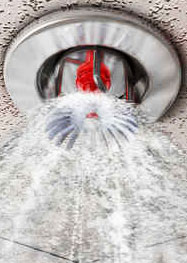 Fire sprinkler systems needed for rooms and places where, in the event of a fire, very high temperatures. Fire sprinkler system design includes fire suppression as well as cooling important elements. Water is constantly in the system, and the sprinkler itself (sprinkling installation) is equipped with a thermal trigger mechanism. When the temperature rises to the designated level, the thermal lock is unsoldered or the bulb covering the head bursts, and the liquid irrigates the planned area.
Fire sprinkler systems needed for rooms and places where, in the event of a fire, very high temperatures. Fire sprinkler system design includes fire suppression as well as cooling important elements. Water is constantly in the system, and the sprinkler itself (sprinkling installation) is equipped with a thermal trigger mechanism. When the temperature rises to the designated level, the thermal lock is unsoldered or the bulb covering the head bursts, and the liquid irrigates the planned area.
Deluge fire extinguishing systems
Deluge fire extinguishing systems used on larger areas. They must extinguish fires and prevent the spread of fire. Therefore, when designing a deluge fire extinguishing system, one of the tasks involves installing water curtains. The drencher, unlike a sprinkler, does not have thermal locks. The system is started either by a person or by a system sensor. Such installations are usually not filled with anything, and the extinguishing agent (water/foam) is supplied only after a signal. The deluge option is often installed in places where the risk of fire is low and the expected damage is minor. A wall of water/foam extinguishes the fire and prevents it from going further, which is why deluges are often placed in corridors and doorways, as well as around possible sources of fire.
The agent that the system uses to extinguish the fire also plays a role:
- Design systems powder fire extinguishing involves work special equipment with mineral salt saturated with special additives (their composition is determined by the designers according to the purpose of the system).
- Design water fire extinguishing systems For calculations, it uses the usual and most common installations that extinguish the flame by injecting water. Similarly with foam fire extinguishing, when special foam is used.
- Design gas fire extinguishing systems- a rare option, but one of the oldest. To extinguish fire, installations that spray carbon dioxide. Such systems are sometimes installed on industrial facilities for a specific purpose.
Foam fire extinguishing
Foam fire extinguishing is effective by combining the advantages of using water and dry components on fires. The foam fire extinguishing project is being developed to ensure the rapid elimination of fires at facilities where the use of powder formulations or water will be useless or ineffective. Examples of such objects are warehouses (storages) paint and varnish materials, fuels and lubricants, oil and petroleum products.
Fire extinguishing with water mist
The water mist fire extinguishing project implemented efficient system elimination of fires, allowing to reduce installation and implementation costs, as well as to eliminate damage from excessive flooding with water. The high penetrating ability of finely sprayed water ensures reliable fire extinguishing with low consumption of the substance. The systems are recommended for use in archival, museum, office premises, libraries.
Aerosol fire extinguishing
Efficiency aerosol fire extinguishing consists in the extinguishing abilities of a hot stream of solid particles and gases formed during the combustion of chemical substances that are part of the aerosol mixture. In the design of an aerosol fire extinguishing system, the main equipment is a fire extinguishing aerosol generator (FAG), which is triggered automatically or manually activated. The use of the systems is universal, but there is a ban on use in premises where evacuation of people is not possible before turning on the GOA.
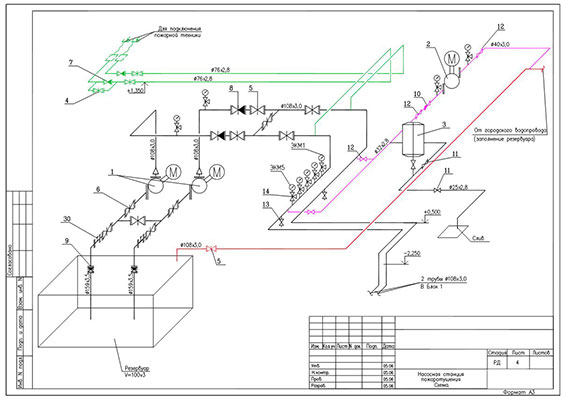 Systems Design fire safety is performed in several stages:
Systems Design fire safety is performed in several stages:
- Study and assessment of the premises that the system will protect. Determining the premises in which it is necessary to install a ceiling made of polystyrene foam tiles. When the territory is determined, the actual design of water and foam systems begins. automatic installations fire extinguishing
- Determining the location of irrigation heads.
- Determining the location of the pump.
- Determination of extinguishing agent supply routes (water/foam/powder).
- Determining the location of fire sensors.
- Determining the location of water intake points.
- Calculation of pump power, tank volume, type of substance (water/foam/powder), type of system (deluge/sprinkler).
- Project approval. We can guide him through this to speed up the approval process.
Since we carry out the design and installation of fire extinguishing systems, after approval of the project we can continue working with you as an installation company.
During installation, our specialists:
- Equipment is selected according to the parameters calculated in the project and delivered to the site.
- Lay cable routes and water pipelines.
- Install control panels, pump, sensors, irrigation devices.
- Integrate the system into utility networks.
- Carrying out commissioning work.
As a result you get working system fire extinguishing services that we can vouch for. The fire will no longer threaten the territory entrusted to you.
The main goal pursued by the development of the project is to determine maximum efficiency type of future installation, taking into account all the features of the room.
Specialists developing a fire extinguishing system design must take into account a number of factors:
- purpose of the premises;
- fire hazard class of the building;
- state engineering communications(especially when it comes to choosing water fire extinguishing);
- the type and availability of materials and resources stored in the building;
- customer budget, etc.
All work during the design process must be carried out taking into account the requirements of GOST, PUE rules (rules for installing electrical equipment) and NPB (fire safety standards). This means that specialists must combine the requirements of the customer and regulatory authorities.
Before starting to draw up a project, specialists visit the site to clarify the characteristics of the room and its dimensions. As a result, the design of fire extinguishing systems allows for maximum effective compliance regulations and in the event of an emergency prevents material losses, and most importantly, human casualties.
Design of fire extinguishing installations
This part of the specialists’ work is aimed at preparing theoretical and graphic documentation. The first category provides detailed justification for the choice of equipment to be installed and Supplies. Specialists offer floor plans showing all components and components of the system (laying cable networks, etc.). Work on the design of fire extinguishing installations should not leave any detail unattended.
Fire system design
The first stage of designing an automatic fire alarm reveals the most dangerous and complex areas where there is an increased likelihood of fire. Taking into account these data, documentation is prepared on the basis of GOST, PUE and NPB. Having drawn up the project, it is necessary to approve it with state supervisory authorities, having received permission to enter fire system into operation.
After all approvals and approvals, the project can be launched. It becomes a guide when executing installation work. Each customer should understand that it is better to order the entire range of fire safety work from one company, which significantly simplifies the interaction between individual departments performing different tasks.
It is necessary to entrust the preparation of the project to trusted specialists who have permission from supervisory authorities for this type of activity. In this case, there is no doubt that the project will be drawn up competently and quickly, and the process of its approval will not cause any complaints from the supervisory authorities. In addition, the installation process will be easier and faster, saving not only time, but also materials and equipment. The design of fire extinguishing systems should be carried out taking into account the use of only specialized equipment, since some parts of the system during the installation process are customized individually for each project. Saving on materials and equipment when drawing up a fire safety project is not the most The best way get rich.
A well-designed project will allow you to control the temperature in the premises and promptly detect and eliminate fire and smoke by sending an alarm signal.
Design of fire sprinkler systems
A fire sprinkler system includes a piping system filled with a fire extinguishing agent. The pipeline is equipped with special low-fusible nozzles (sprinklers), which are opened at the initial stage of the fire, providing fire extinguishing agent to the source of fire.
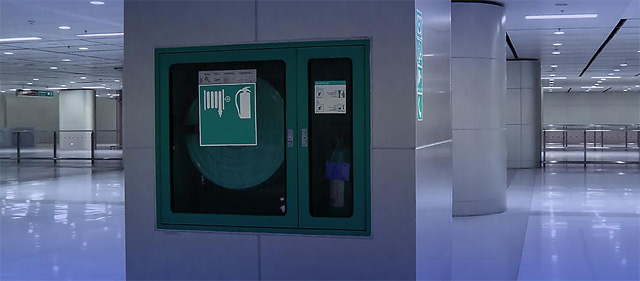
The design of fire sprinkler systems is necessary for rooms with a height of no more than 20 meters. An exception may be installations designed to protect individual structural elements of structures and buildings.
The very first stage of design is determining the diameter of the future pipeline in accordance with the developed standards. The diameter of the pipes is selected to calculate the flow to the sprinkler required quantity water to fight fire. At the same time, you need to take into account the shape of the jet, the area that will be covered by it and many other factors. Since developing a fire sprinkler system project is a complex and responsible job, it should be trusted to professionals with certain experience. Without knowledge of all kinds of regulations and safety precautions, skills in using high-quality components, it is impossible to quickly develop a project that will be approved by the supervisory authorities.
Installation of fire sprinkler systems must be carried out in strict accordance with the design, using elements approved for use, installation of sprinkler and deluge systems, pumping stations and pumps, threaded and coupling connections, tanks in accordance with SNiPs and other regulatory documents.
When installing sprinkler fire extinguishing systems in rooms where there are installations with non-insulated live parts that are energized, it is necessary to use the system automatic shutdown electricity, which will turn off the voltage until the fire extinguishing agent is supplied to the fire. This point must be taken into account when designing.
The fire sprinkler system includes:
- upward pumping station, which includes control units, consoles and pumps;
- shut-off control valves;
- supply pipelines;
- sprinklers.
The components of such a system also include various alarms, pressure and flow switches, solenoids, valves, clamps, pipe hangers, etc. High-quality installation and timely maintenance of fire sprinkler systems allows this system to effectively fight fires. That is why the sprinkler system has found widespread use in the fight against fires of class A to C.
It is difficult to find a more effective composition that fights fire than water. Her specific heat capable of exerting strong mechanical impact to the fire. In addition, water is easily supplied over the longest distances. The foam contained in the foam fire extinguishing installation makes it possible to localize the source of combustion perfectly. A clear advantage of such a system is that the fire extinguishing agent for it is relatively inexpensive, which saves money. One wall-mounted automatic sprinkler system can protect an area of 16 square meters. meters.
By entrusting all stages from installation to maintenance of the fire sprinkler system to reliable specialists, you can count on the reliability of the system, its technical and economic feasibility, speed of action, and aesthetic appearance.
Design of powder fire extinguishing systems
Of all types of fire extinguishing systems, the most optimal is the powder fire extinguishing system, which perfectly fights fire regardless of the nature and source of ignition. This system is used all over the world to eliminate and localize fires A, B, C, D , class.
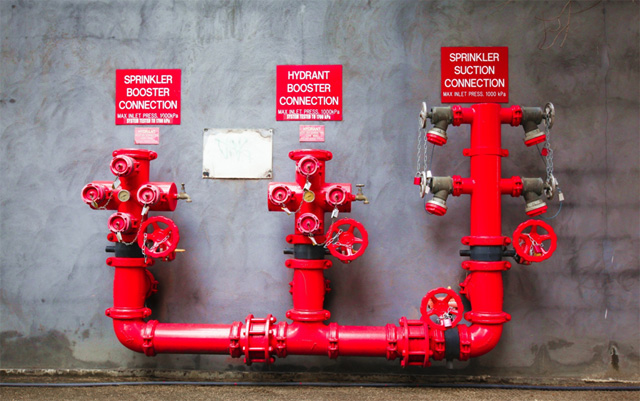
At any facility, in the event of a fire threat or fire of any complexity, such a system is very effective. The principle of this automatic system– localize and extinguish a fire of any nature using a fine powder mixture, which, when the alarm is triggered, is released under pressure at the source of the fire.
Advantages of powder fire extinguishing system:
- rapid elimination of the source of fire;
- environmental friendliness;
- used without human intervention;
- universal in use;
- low cost of the system.
It is especially advisable to design powder fire extinguishing systems in rooms where energized electrical equipment is located or at facilities where the use of water fire extinguishing systems is impossible for a number of reasons. This cost-effective method of fire protection does not damage property, but cleanup is required after the fire is extinguished.
Designing a system requires several stages:
- careful familiarization with the object, taking into account the study of the features of the layout and architecture;
- familiarization with data on the purpose of the facility, as well as the number of equipment and personnel located on it;
- taking into account the main requirements of the customer;
- drawing up an initial project indicating the main points;
- inventory of equipment and coordination of all technical aspects;
- final design;
- final approval of the project with control services and the customer.
The cost of project development and installation of powder fire extinguishing systems depends on a number of factors (room area, its functional features, space-planning solution, choice of equipment, etc.). Automatic powder fire safety systems are divided depending on the extinguishing method into local in volume, volumetric and local in area.
The system can be installed using one of three types of launching a powder fire extinguishing system:
- autonomous installations that independently detect the source of fire and automatically spray the reagent regardless of external power sources and control;
- remote or local installations with manual start, which are activated by a signal from a fire extinguishing station or fire station;
- automatic installations that, using a fire detector, start the system after detecting a fire.
The reagent in powder plants is universal substance, which corresponds to different fire classes:
- for extinguishing solids- class A powder;
- for liquid substances – class B powder;
- for metals and gaseous substances– classes C and D;
- for live equipment – class E.
The undeniable advantage of such a fire extinguishing system is trouble-free operation even at low temperatures, when it is impossible to use water or foam.
Maintenance of powder fire extinguishing systems also does not cause any difficulties and should be carried out at regular intervals by the efforts of specialists. This system is optimally suited for unheated rooms, and the low cost of the powder installation has made it the most popular of all available fire extinguishing systems.
Design of deluge fire extinguishing systems
Today it is becoming obvious that deluge fire extinguishing systems are the simplest and most economical way to identify and localize fires of any complexity at sites. Proper design of deluge fire extinguishing systems allows long time ensure its uninterrupted operation without requiring periodic maintenance and repair of individual components.
Modern deluge fire extinguishing systems allow you to very quickly localize the location of the fire and cope with the fire. Unlike the sprinkler system, the deluge system does not have a thermal lock. This means that at the moment of fire, water is sprayed immediately from all deluges installed in the premises, and not over the source of the fire. The water supplied by deluges spreads in the form of mist, rather than flowing in a continuous stream. This approach allows you to significantly reduce the temperature in the premises, thereby stopping the combustion process.
An important advantage of all water fire extinguishing installations, which include deluge systems, is the availability of water (the main working fluid). All water installations are as economical as possible and absolutely safe for human health. The most noticeable disadvantage of such a system is the significant damage caused after installation and the limited scope of application. It becomes obvious that no fire extinguishing system is suitable for installation in power plant buildings, data centers, server rooms, chemical laboratories and warehouses where chemicals that can react with water are stored. Today for different types buildings and premises are used different installation deluge fire extinguishing systems using a variety of installations.
Translated from English, “drencher” means “to water”, “to irrigate”. Most often, these systems are installed at special facilities with high degree fire hazards (fuel warehouses, storage areas for flammable substances, gas stations, nuclear power plants, retail and administrative buildings, hotels, utility rooms, etc.). Installation and maintenance of deluge fire extinguishing systems must be carried out by qualified specialists, taking into account all technological requirements.
The design of such a system includes the following equipment:
- a supply pipe filled with an aqueous solution or water. It can be the water supply of a pumping station;
- deluge sprinklers;
- deluge valves of various models.
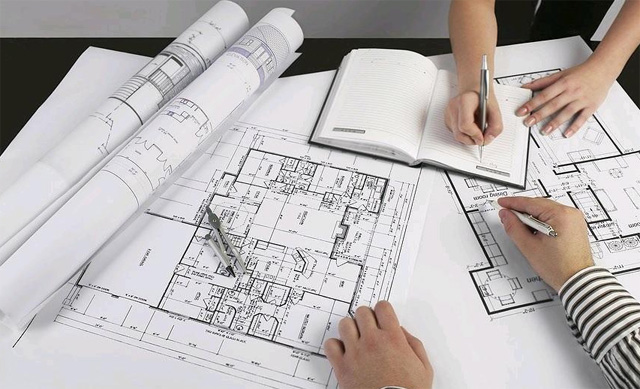
When choosing equipment for the system, it is necessary Special attention focus on quality. This is a very important point, allowing not only to significantly facilitate the maintenance of the system, but also in the event of a fire, to successfully eliminate the source. The system is especially relevant at facilities where fire can spread at lightning speed across the territory (paint and varnish factories, oil refineries, etc.). The principle of “curtains” that are used in this system creates the effect of a water wall, which cuts off other rooms from the source of fire and prevents the further spread of fire. That is why deluge curtains are placed in door and window openings and in other places where there is a possibility of penetration into neighboring premises.
Starting an automatic deluge fire extinguishing system can be carried out in several ways:
- dry start;
- wet start;
- auto start
By entrusting the design development, installation and maintenance of deluge fire extinguishing systems to trusted specialists, you can count on its trouble-free, long-term operation and immediate response in the event of a fire threat.
Design of aerosol fire extinguishing systems
The use of an aerosol fire extinguishing system involves the use of a special aerosol as a fire extinguishing agent, which has a powerful fire extinguishing ability. All manufacturers of such aerosols adhere to the same principle - when certain chemicals that are part of the aerosol are burned, a hot stream of a mixture of gases and solid microparticles appears. This mixture fills the room and extinguishes the flame.
What makes such systems popular is their low installation cost, ease of use, long term operation and non-toxicity. Aerosol fire safety systems are especially relevant when extinguishing liquid and solid flammable substances, operating electrical equipment, as well as electrical insulating materials.
Ordering a design aerosol systems fire extinguishing, you will get a fairly effective and inexpensive way to identify, localize and extinguish fires of any complexity.
The effectiveness of this system is determined by a number of high indicators:
- high fire extinguishing ability of the AOS (aerosol-forming composition) and the fire extinguishing aerosol generator;
- During fire extinguishing, an intensive supply of AOS is maintained, which creates a fire extinguishing environment.
When working on a project for an automatic aerosol fire extinguishing system, specialists are required to develop and approve the technical specifications for the project, articulating the requirements for the protected premises. This approach makes it possible to clearly determine the type of fire extinguishing aerosol generators and the fire extinguishing method. The task of specialists also includes determining the characteristics of the installation, its parameters, taking into account the characteristics of the protected premises (degree of fire and explosion hazard). The project determines the location of generators and installation elements. At the final stage, the design documentation is fully agreed upon with the customer and supervisory authorities, after which the project is approved. The cost of the project depends on the area and functional features premises, space-planning solutions, etc.
The effective composition that is in the installation is capable of achieving several goals at once:
- dilute the source of fire with inert gases;
- slow down most reactions possible during combustion;
- reduce the fire temperature due to the specific gravity of aerosol particles.
If the installation of aerosol fire extinguishing systems is carried out efficiently, then when the aerosol stream is sprayed, its solid particles take the form of a film, automatically blocking the access of oxygen to the source of fire. This film can be easily removed after extinguishing the flame without damaging the surface.
Aerosol fire extinguishing systems are today an excellent alternative to harmful fire extinguishing systems based on freon, which the whole world has abandoned. The composition of aerosol-forming substances includes solid highly dispersed particles, in which the dispersion value does not exceed 10 microns, as well as inert gases.

Regular maintenance of aerosol fire extinguishing systems will allow you to trouble-freely combat the source of combustion, preventing the occurrence of fire, explosion, in enclosed buildings and indoor structures. This method of fighting a fire has its own distinctive properties. This is primarily a high fire extinguishing ability in comparison with other known powder and gas compositions.
By entrusting the development of the project, installation and maintenance of aerosol fire extinguishing systems to proven specialists, you will receive trouble-free operation and fast reaction systems in case of fire hazards.
Design of gas fire extinguishing systems
Accuracy and efficiency are two decisive factors that determine success in extinguishing a fire of any complexity. To achieve this, it is necessary to choose a reliable and well-functioning fire fighting system. Analyzing different systems, experts advise ordering the design of gas fire extinguishing systems, which have proven themselves and are widely used throughout the world.
![]()
Such installations are indispensable at facilities where it is impossible to use water as a fire extinguishing mixture; in places where explosive substances are located, there is a possibility short circuits or in rooms where the temperature drops below 0°C.
The gas fire extinguishing system has no competitors at gas pumping stations, in places where the protection of cultural property is necessary (exhibition halls, archives, libraries, storage rooms, galleries), on sea vessels, in premises where electronic equipment is located (server rooms, automatic telephone exchanges, data centers, etc. .), in paint shops and deposits where there is a highly explosive atmosphere.
The characteristics of gas fire extinguishing installations allow it to be used where other fire extinguishing methods cannot be used. To spend high-quality installation gas fire extinguishing systems, it is necessary to correctly select the type of such installation, draw up a diagram and calculation of gas fire extinguishing.
There are two types of gas fire extinguishing systems: modular and centralized. The choice of type should be made in accordance with the number of premises protected from fire, their type and area. Guided by these parameters, specialists calculate a gas fire extinguishing system that will most effectively, if necessary, identify, localize and extinguish a fire with a mass of gas. An important advantage such a system is that the gases used in it are absolutely non-toxic and will not cause harm to human health and environment. They can be easily removed from the room after use; you just need to ventilate it. Using this system, you can count on the fire being extinguished in any part of the room. At the same time, your furniture, equipment, documents and various valuables that will not reach the fire will remain safe and sound. Installation gas equipment Fire extinguishing systems operate reliably in a wide temperature range (from – 40 to + 50 ° C). No other fire extinguishing system can boast of this.
All these advantages will become obvious only if the design, installation and maintenance of gas fire extinguishing systems were carried out with the involvement of competent and responsible specialists.
Unfortunately, during the development of the project, mistakes may be made, including the lack of hydraulic calculations installations, determination of pipeline diameter, lack of indication of the area of spray nozzles, lack of calculation technical means, which provide control of the mass of the fire extinguishing agent gaseous substance And so on. To prevent this from happening, contact a company that has enough experience in carrying out this work.
All of the above work must be carried out in accordance not only with the customer’s requirements, but also regulatory requirements. Otherwise, the project will not be approved by supervisory authorities. It is always beneficial to order the service of designing a gas fire extinguishing system in combination with other services aimed at ensuring the fire safety of the facility. This will allow you to count on high-quality performance of all stages of work, as well as receive discounts, which makes operating the system more cost-effective.
Fire extinguishing is a set of measures, technologies, and means designed to eliminate a fire. Ensuring the safety of people, buildings and property located in them is calculated at the design stage of alarm and fire extinguishing systems.
Rice. Internal engineering systems. Design of fire extinguishing systems.
Automatic fire alarm design
Fire alarm, designed in accordance with established safety requirements and also taking into account the characteristics of the building, is a key part of the entire fire extinguishing system. The design of fire alarm systems begins with training by our employees terms of reference based on data from the customer and all his wishes. Then the number of sensors required for the entire structure or a specific room is calculated, their optimal location. Automatic systems can be equipped with devices that respond to smoke or rising temperatures in rooms. The receiver in contact with the sensors receives information from them and processes it, activating the fire extinguishing system.
Designing an automatic fire alarm system ensures the effective functioning of the entire fire extinguishing system. In addition to its main role in informing about the occurrence of a fire, automatic devices capable of blocking exits and turning off electricity, as well as starting smoke removal systems.
Designing fire extinguishing systems is unthinkable without defining them the right type. The final cost of all work, as well as the amount of damage incurred after extinguishing, depends on which type is chosen.
Fire extinguishing systems that can be constructed based on the design results are:
foam;
water;
water-foam;
gas;
aerosol;
powder
The design of automatic fire extinguishing systems is carried out taking into account thermal regime premises. For unheated parking lots, hangars and others storage facilities it is best to use powder or gas fire extinguishing. In residential buildings, where the air temperature is always positive values, the most effective way to extinguish a fire is with foam or water.
The internal equipment of the building, namely the presence of valuables and documents, also affects the development of the project. Thus, the design of water fire extinguishing systems is rarely practiced in conditions where it is necessary to protect works of art, securities and other items that can be seriously damaged by water. In such cases, it is advisable to use a gas that does not have any effect on material objects. Premises with office equipment will also remain unharmed when using powder or gas.
One of the main activities of our company is the design and implementation of fire extinguishing systems of all types. We offer the most favorable conditions, as well as an individual approach with attention to any of your wishes. Our specialists have extensive experience in the development and installation of automatic fire extinguishing systems that can guarantee complete safety of people and property. Correct design of these communications ensures operability and high level reliability of the entire complex of devices, so such solutions should only be developed by professionals!
The Helios company, having direct experience in the development, installation and maintenance of fire safety systems, understands all the responsibility for such important stage, like designing.
That is why specialists have developed an algorithm for interaction with the customer that brings the most effective results. The company's employees inspect the facility, study its features, which have a direct impact on the entire fire extinguishing system project. A qualified designer works on data collection, takes measurements, and clarifies the initial parameters.
After creating the project, the stage of coordinating it with the client follows, during which the rationality of choosing this or that equipment and installing the stated number of sensors is discussed. The client will also be offered approval of all project materials in government agencies.
Prices for designing fire extinguishing systems
After you make a request for the installation of a fire extinguishing system by calling us at the phone number listed on the website in the “Contacts” section, an engineer will visit your site and take all the necessary measurements. In accordance with the customer’s wishes, several versions of such systems will be developed, relating to different price categories.
Contact us
Submit your application
Fire extinguishing system design in detail
Helios specialists will design a fire extinguishing system quickly, professionally, in accordance with your wishes and regulatory requirements. IN finished project All main parts of the system and subsystems, their locations and patterns of interaction with each other will be indicated. For example, from the above document it will be clear which secure line will be used to notify the building about a fire. Where exactly will the water supply system be laid to supply water to the fire extinguishing system? The location of the lightning rod, smoke protection equipment, sensors, warning devices and many other elements.
How we do it:
![]()
The price for developing an automatic fire extinguishing system project generally depends on the area of the room in which it will be located.
To make such a design, an engineer needs to find out a lot of different data. Where are the existing fire exits located in the building, and are they sufficient for the smooth evacuation of the existing number of employees? What will be the pathways for fire to spread from likely fire locations? Are there security posts on the floors, and what is the best way to connect a fire alarm to them (if possible, integrating it with burglar alarm, if it exists)? Dozens of answers to such questions will become the basis of the future system design.




